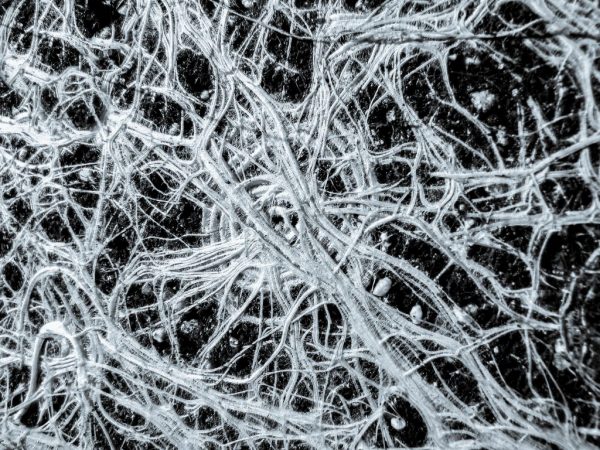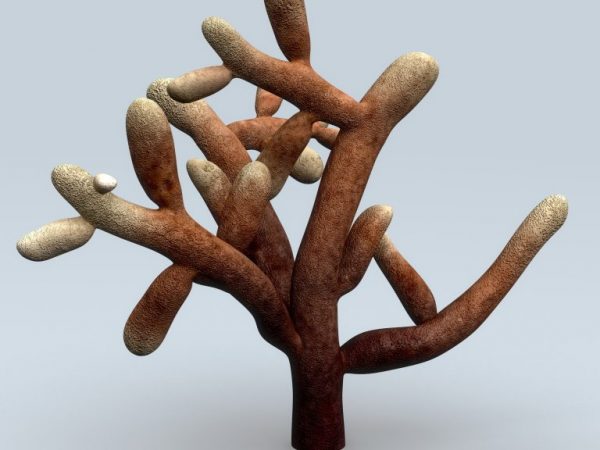What is fungus root
Everything on our planet is interconnected. A striking example of this is the concept of "mushroom root". If this word is disassembled into its components, then it will immediately become clear whether it means the life of a fungus on the roots of plants. This is one of the important stages of symbiosis, which implies the life of a representative of one class at the expense of another and has a name - mycorrhiza. But this is not always the case in nature. Some fungi do not form mycorrhiza and develop independently.

Mushroom root
What is fungus root
What is fungus root or mycorrhiza? The answer to the question lies in the science of biology and the processes of symbiosis in nature. So, many organisms cannot develop independently throughout their life. To survive, they parasitize at the expense of individuals of other systematic categories, often of a higher class.
The concept itself is embedded in the word. This is one of the facts of the existence of a tandem between representatives of fungi and plants: the fungus develops on the roots of trees and shrubs, it forms a mycelium, which penetrates into the thickness of the plant root bark.
There are several types of mycorrhizal fungi that can develop both on the surface layers and penetrate directly into the thickness of the root, sometimes piercing it through and through. This is especially true for shrubs.
Such symbiosis is a kind of parasitic stage, it does not have a negative effect on the host itself - they feel great in interaction with each other. Even better than separately. To some extent contributing to the life and development of each of the species.
Does it harm
The mushroom feeds on its "owner" - and this is an indisputable fact. But if you conduct detailed research, then you can emphasize the benefits for each of the parties.
Mycorrhizal fungi, developing on plants, feed mainly on carbohydrates, which are the basis for life. And this is not a small part of the nutrient, since it is important for mushrooms not only to satisfy their needs, but also to be able to develop spores. But considering its size in relation to a tree and shrub, the latter are quite capable of feeding their parasite without feeling harm to themselves. Due to the lack of green plastids - chloroplasts, fungi are not capable of the process of photosynthesis, which means they are not able to synthesize carbohydrates necessary for their vital activity.
At the same time, the mushroom itself also helps the plant to develop normally, providing it with the necessary nutrients - it supplies minerals. And he also makes the roots of the plant looser, due to the fact that they are intertwined with mycelium. The porous structure allows the plant to absorb more moisture and, accordingly, additional nutrients.
At the same time, there is an additional quality - the ability to extract nutrients from different types of soil.As a result, when the tree is unable to obtain the necessary components from the environment, the mycorrhizal fungus comes to the rescue, delivering an additional portion for life and development for itself and its owner. That will not allow both representatives of this formation to dry out.
Varieties

Trees become the basis for the fungus root
The following types of mycorrhiza are distinguished:
- Myccorisa ectotrophyca - spreads only in the upper layers;
- Myccorisa endotrophyca - mycelium develops in the thickness of the root, sometimes piercing the body almost through;
- Еctotrophyca, endotrophyca myccorisa (mixed type) - characterized by the peculiarity of each of the upper species, spreading its mycelium both on the surface and in the root;
- Peritrophyca myccorisa is a simplified form of symbiosis and at the same time a new stage in development. It is the placement of hyphae near the root without the penetration of processes into it.
Whatever the type of mycelium, it is intended for a specific group of plants. Bushes and trees become the basis for the development of one type of fungus root, but they can become carriers of other parasites.
What mushrooms form mycorrhiza with roots
There are several groups of plants with which fungi usually form mycorrhiza:
- Higher spore (ferns);
- Gymnosperms;
- Monocots;
- Dicotyledons;
- Orchid family.
Mycorrhizal fungi usually include the beloved porcini mushrooms, aspen mushrooms, honey mushrooms, chanterelles, boletus mushrooms.
Irina Selyutina (Biologist):
It was not easy to decide which mushrooms and with which plants form mycorrhiza. A number of methods have been proposed, including fantastic ones. However, in 1936 the Swedish scientist E. Melin proposed a simple but effective way to solve the problem. For this he took a chamber consisting of two interconnected flasks and a water one from them grew a pine seedling under sterile conditions. Then the fungal mycelium, taken from a young fruiting body at the border of the cap and the leg, was introduced into the same chamber. The second flask was designed to accommodate the liquid needed to moisten the soil. So for the first time the synthesis of mycorrhiza was carried out under experimental conditions. By 1953, Melin's method helped to prove the connection of representatives of various tree species with 47 species of fungi from 12 genera.
Some types of mushrooms got their name precisely due to the spread on a certain representative of plants. For example, aspen and aspen, birch and boletus, as well as others.
It should be noted that a representative of the genus of mushrooms, characterized by the presence of toxins dangerous to humans, the fly agaric, forms mycorrhiza on the surface of the roots of coniferous trees. And although it is not edible, it provides its "owner" with nutrients by 100%.
Non-mycorrhizal fungi
The following groups are included in the category of fungi that do not form mycorrhiza:
- Saprophytic mushrooms (mold and cap fungi): their mycelium forms in the surface layer of the soil rich in humus. They independently release enzymes to extract nutrients from the soil, or rather from the rotting remains of plants and animals in it. Play an important role in the ecosystem. For example, by recycling most of the organic matter on the surface of the earth;
- Fungi-symbionts (a group of parasites): the very definition implies life at the expense of its host. But the symbionts lead to the depletion of the latter. For example, a honey agaric can develop and completely deplete a tree, while after its destruction, it will process the remains of its "owner" for a long time. Fungi that live on other mushrooms fall into the symbiont category.
Functions of mycorrhiza for growing plants
The main functions of mycorrhiza were the impetus for its use in the household:
- Ability to release protein as an important natural catalyst;
- Digestion and breakdown of nutrients from plant remains;
- Absorption of readily soluble mineralized elements from humus;
- Providing the host with vitamins, minerals, hormones and enzymes.
As a result of the mutual growth of trees together with mushrooms, their joint active existence occurs. Each of the representatives receives their part of protection and "immunity" from external factors. So, for the fungus there is a zone for parasitism, for a tree - additional protection in case of insufficient moisture or depletion of the soil, as well as diseases.
Conclusion
In the world there are fungi that do not form mycorrhiza, and those that form it. Among all the listed species, there are both edible and poisonous. But it is necessary to understand that each representative is very important, he performs certain functions in nature and without him, perhaps, some vital biological processes would not have occurred.


